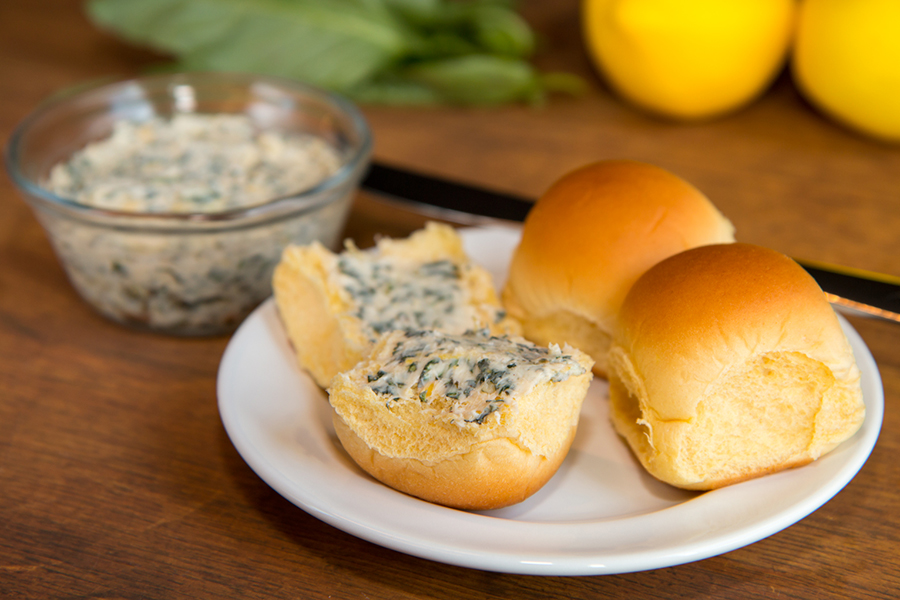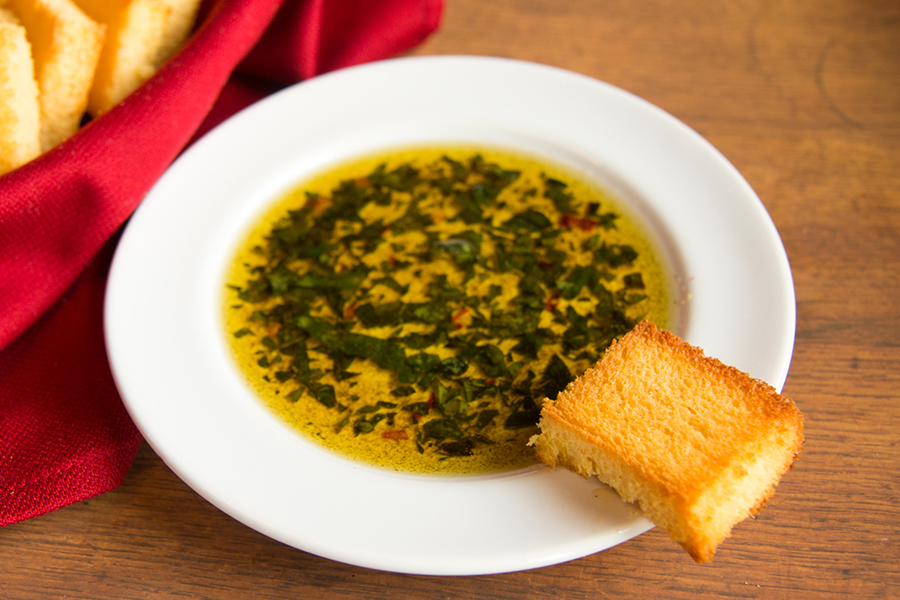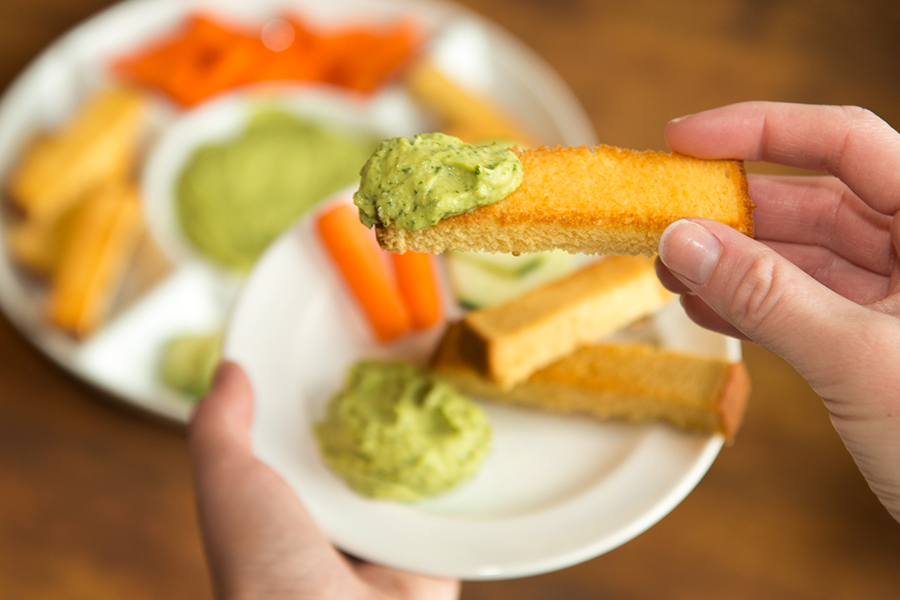Nothing says “springtime” like some fresh herbs to brighten up your kitchen! To accompany our Homegrown Resource Page, here is a list of our 12 favorite herbs to use in cooking. Try planting some of these in your spring garden so you can “make it flavorful” all season long. Read on for some great recipes and helpful tips for growing your favorite herbs at home!
Basil
While there are many varieties of basil, the most well-known are Sweet Basil (think Italian cuisine) and Thai Basil (think Asian cuisine). Use in pesto, caprese salad, soups, pizza, drinks, etc.
{Basil} Herb Butter:
Herb butter is a great vehicle for excess herbs from your garden. It is simple to prepare and can add a ton of flavor to your meals. Our version uses basil, but you can use any combination of herbs you would like including thyme, sage, parsley, dill, chives, tarragon, oregano, or rosemary.
To make: start with ½ cup (1 stick) unsalted butter, add finely chopped herbs, salt, pepper, and any other flavor enhancements such as minced garlic or lemon zest. Mix the ingredients until well combined, then use as a spread on grilled veggies or dinner rolls. Alternatively, you can shape the butter into a cylinder using parchment paper or plastic wrap, twisting the ends until sealed. Then chill in the refrigerator until firm and use it melted over grilled meats, or mixed into dishes such as pasta or potatoes.
Chives
Chives are a member of the onion family and have a mild onion taste. They go well with cheese, eggs, potatoes, or as a garnish.
Coriander/Cilantro
Coriander is both an herb and a spice, as both its leaves (more commonly known as cilantro) and seeds can be used in cooking. The leaves, which resemble parsley, are commonly used in Mexican and Latin American cuisine such as salsa and guacamole. Meanwhile, coriander seeds are used frequently in Indian dishes such as curries.
Dill
Dill is best known for its use in pickling, but can also be used to accompany fish, chicken, and potatoes, or in soups and dips.
Lavender
Lavender is a very fragrant, floral herb that is often used in aromatherapy to help relieve stress. Culinary lavender can be infused into desserts and baked goods or used in teas.
Mint
Mint is a cooling, refreshing herb that is often added to cold juices and drinks, or paired with various vegetables or meats. It is often used in Mediterranean, Middle Eastern, and African cooking.
Oregano
Oregano is a strong, fragrant herb that goes well with Italian dishes such as pasta and pizza, and also numerous other dishes such as poultry, lamb, seafood, and potatoes.
Herb Dipping Oil
Go to any nice Italian restaurant, and you’ll likely be served bread with Italian dipping oil before your meal. This is a fun and easy way to elevate your next dinner party. Toast up some bread or rolls for dipping, then pour olive oil onto a shallow plate and add herbs and spices such as garlic, oregano, basil, rosemary, marjoram, thyme, and red pepper flakes.
Parsley
Parsley has a mild, grassy flavor that can accompany a wide variety of dishes. It is often used in French cooking and as a garnish.
Avocado Herb Dip
Sometimes called “Green Goddess Dip” because if its bright color, this dip can be made with a variety of herbs and ingredients. Our version uses avocados, scallions, parsley, basil, lemon juice, Greek yogurt, and salt. Other versions also incorporate chives, tarragon, or anchovy. Serve as a dip or spread with veggies and toast, or thin with olive oil and use for a dressing.
Rosemary
Rosemary is a very aromatic herb with a woody characteristic that resembles lemon and pine. It is used in much Mediterranean cooking and pairs well with lamb, olive oil, garlic, potatoes, and poultry.
Sage
Sage is another Mediterranean herb and resembles the flavors of eucalyptus and mint. It goes well with dishes like veal, sausage and cured meats, as well as turkey and stuffing (think Thanksgiving).
Tarragon
This herb is frequently used in French cuisine and boasts a sweet, licorice-like flavor. Pair it with fish, chicken, or essential French sauces like béarnaise.
Thyme
Another fragrant herb, thyme integrates well into a variety of dishes like soups, stews, and poultry entrees. It is often paired with rosemary and sage for use in roasted or grilled meats.
Tips and Tricks
- Chop up your leftover herbs and freeze them in olive oil inside ice cube trays. Not only does this help them stay green longer and prevent them from getting freezer burn, but it also ensures you have herbs for your dishes after the growing season has ended. To use, just pop out a cube or two and add it to soups and stews, or as a base for your dish. This method works best for hardy herbs like rosemary, sage, thyme, and oregano. (Source: thekitchn.com)
- If growing herbs indoors, try to place them on a windowsill in a room that gets at least 4 hours of natural sunlight a day. (Source: bonnieplants.com)
- Reader’s Digest has some great tips for the best herbs to plant at home.
- If you’re not sure whether to plant your herbs indoors or outdoors, check out Planet Natural‘s guide to “Herb Gardening 101.”
Any links to other sites on this website are provided for information only – such links do not constitute endorsements of those other sites. See our Terms of Use and Privacy Policy regarding use of this website.
Our latest content, delivered straight to your inbox.
Be the first to hear about our newest recipes, tips, and company updates!







